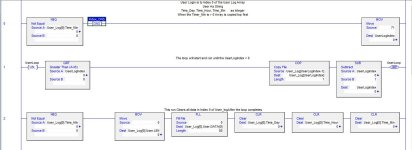Hello everyone, I am working on trying to record a history of user logins with a time stamp. It will record their user ID and the time that they logged in on a PanelView Plus 7 1200.
I am programming the PLC (1756-L82ES) in Studio 5000 (v32) and trying to use the FAL instruction to shift a couple of arrays. One is an array of STRINGS containing the user ID and the other is an array of a Date and Time UDT which is a 7-DINT array to capture the time stamp.
I quickly discovered that the FAL expression and destination tags cannot be of the datatype STRING or a UDT. I thought maybe using STOD and vice versa to sort out the user ID but I think I would have to do that for each element in the array. I am not sure how I would do the timestamp other than maybe having a separate array for each element such as Year[50], Month[50]...etc.
Does anyone know an easy way to accomplish what I am trying to do?
I am programming the PLC (1756-L82ES) in Studio 5000 (v32) and trying to use the FAL instruction to shift a couple of arrays. One is an array of STRINGS containing the user ID and the other is an array of a Date and Time UDT which is a 7-DINT array to capture the time stamp.
I quickly discovered that the FAL expression and destination tags cannot be of the datatype STRING or a UDT. I thought maybe using STOD and vice versa to sort out the user ID but I think I would have to do that for each element in the array. I am not sure how I would do the timestamp other than maybe having a separate array for each element such as Year[50], Month[50]...etc.
Does anyone know an easy way to accomplish what I am trying to do?





